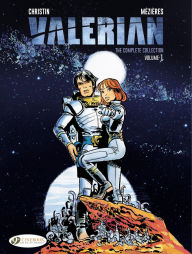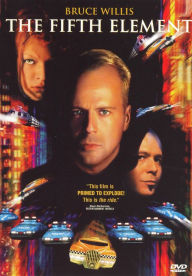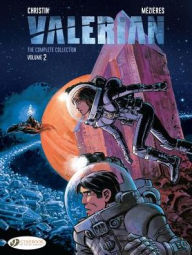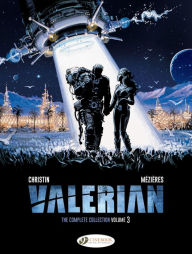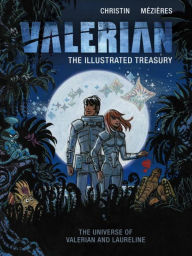Valérian and Laureline Is the Essential Space Opera You’ve Never Read
 For over four decades, the intergalactic adventures of jet-setting spacetime agents Valérian and Laureline were one of the biggest things in comics, managing to infiltrate almost every corner of modern pop culture, in their native France and beyond—but they never quite cracked the U.S. market. With a flashy new film adaptation from director Luc Besson hitting theaters, that’s about to change in a big way—but writer Pierre Christin and artist Jean-Claude Mézières’ comics are finally getting their due as well.
For over four decades, the intergalactic adventures of jet-setting spacetime agents Valérian and Laureline were one of the biggest things in comics, managing to infiltrate almost every corner of modern pop culture, in their native France and beyond—but they never quite cracked the U.S. market. With a flashy new film adaptation from director Luc Besson hitting theaters, that’s about to change in a big way—but writer Pierre Christin and artist Jean-Claude Mézières’ comics are finally getting their due as well.
Valerian: The Complete Collection, Volume One
Valerian: The Complete Collection, Volume One
By
Pierre Christin
Artist
Jean-Claude Mézières
In Stock Online
Hardcover $39.99
In the introduction to the first in a new (and, it must be said, rather fancy) series of English-language reprint editions from Cinebook, science fiction critic Stan Barets describes Valérian et Laureline (the lady’s name was inexplicably dropped from the film title, and these reprints have followed suit—for understandable, if regrettable, marketing reasons) as “the original archetype from which everything flows.”
That might be a bit of an exaggeration, but a forgivable one. Read with the context of when it was published in mind, it becomes hard not spot ideas and visual elements were likely cribbed from the colorful sci-fi epic, repurposed in everything from Star Wars to Conan the Barbarian to Besson’s own The Fifth Element.
[caption id="attachment_19299" align="aligncenter" width="550"] Mort de rire[/caption]
Considering its origins, it’s strange that many Americans are only now discovering Valérian, and only because of the forthcoming film. Finding life in postwar France rather colorless, Christin and Mézières visited the US and took inspiration from American science fiction and westerns, filtering childhood fantasies conceived in air-raid shelters through the vivid lens of 1960s American counterculture. The book’s politics are subtle, maybe even a bit muddled in the early volumes, but there’s a sense that the two have things to say—and that they’re thrilled to say them via Valérian and Laureline, two adventurers in time and space traveling to the weirdest (and most beautifully illustrated) worlds imaginable.
In the introduction to the first in a new (and, it must be said, rather fancy) series of English-language reprint editions from Cinebook, science fiction critic Stan Barets describes Valérian et Laureline (the lady’s name was inexplicably dropped from the film title, and these reprints have followed suit—for understandable, if regrettable, marketing reasons) as “the original archetype from which everything flows.”
That might be a bit of an exaggeration, but a forgivable one. Read with the context of when it was published in mind, it becomes hard not spot ideas and visual elements were likely cribbed from the colorful sci-fi epic, repurposed in everything from Star Wars to Conan the Barbarian to Besson’s own The Fifth Element.
[caption id="attachment_19299" align="aligncenter" width="550"] Mort de rire[/caption]
Considering its origins, it’s strange that many Americans are only now discovering Valérian, and only because of the forthcoming film. Finding life in postwar France rather colorless, Christin and Mézières visited the US and took inspiration from American science fiction and westerns, filtering childhood fantasies conceived in air-raid shelters through the vivid lens of 1960s American counterculture. The book’s politics are subtle, maybe even a bit muddled in the early volumes, but there’s a sense that the two have things to say—and that they’re thrilled to say them via Valérian and Laureline, two adventurers in time and space traveling to the weirdest (and most beautifully illustrated) worlds imaginable.
The Fifth Element
The Fifth Element
Cast Bruce Willis , Ian Holm , Gary Oldman , Chris Tucker , Luke Perry
In Stock Online
DVD $9.99
For American science fiction fans who haven’t been introduced to the pair of “spatio-temporal” agents, the aesthetic will still likely be familiar: Mézières was a key consultant and production designer for Luc Besson’s aforementioned The Fifth Element, released in 1997. The success of the original Valérian strips in Pilote magazine directly inspired the creation of Métal Hurlant (aka Heavy Metal) magazine, a book which itself launched a thousand careers and two very strange movies. And then there are those undeniable similarities between the look and feel of Mézières’ work and that other beloved science fiction epic: Star Wars.
There’s plenty of disagreement about how much Star Wars borrowed from Valérian et Laureline, and even whether it was done intentionally, or just through osmosis. Some of it is certainly debatable: Laureline is forced to don a slave-girl outfit in a later adventure, “The Land Without Stars,” but modesty hasn’t traditionally been a defining trait of female SFF characters (see almost any old-school Frank Frazetta book cover for examples).
[caption id="attachment_19295" align="aligncenter" width="550"] Now where have I seen that before…[/caption]
Other things, like Valerian being trapped in a block of “liquid plastic” in 1971’s “Empire of a Thousand Planets” seem a little more on the nose, visually and conceptually. Mézières described himself as “dazzled, jealous… and furious!” upon watching Star Wars for the first time. Coincidental or not, the stylistic similarities are undeniable, and it remains that the comics did much of it earlier: both universes deal strongly in lived-in worlds that still manage to be colorful, given a variety of weird creatures and unique technology.
For American science fiction fans who haven’t been introduced to the pair of “spatio-temporal” agents, the aesthetic will still likely be familiar: Mézières was a key consultant and production designer for Luc Besson’s aforementioned The Fifth Element, released in 1997. The success of the original Valérian strips in Pilote magazine directly inspired the creation of Métal Hurlant (aka Heavy Metal) magazine, a book which itself launched a thousand careers and two very strange movies. And then there are those undeniable similarities between the look and feel of Mézières’ work and that other beloved science fiction epic: Star Wars.
There’s plenty of disagreement about how much Star Wars borrowed from Valérian et Laureline, and even whether it was done intentionally, or just through osmosis. Some of it is certainly debatable: Laureline is forced to don a slave-girl outfit in a later adventure, “The Land Without Stars,” but modesty hasn’t traditionally been a defining trait of female SFF characters (see almost any old-school Frank Frazetta book cover for examples).
[caption id="attachment_19295" align="aligncenter" width="550"] Now where have I seen that before…[/caption]
Other things, like Valerian being trapped in a block of “liquid plastic” in 1971’s “Empire of a Thousand Planets” seem a little more on the nose, visually and conceptually. Mézières described himself as “dazzled, jealous… and furious!” upon watching Star Wars for the first time. Coincidental or not, the stylistic similarities are undeniable, and it remains that the comics did much of it earlier: both universes deal strongly in lived-in worlds that still manage to be colorful, given a variety of weird creatures and unique technology.
Valerian: The Complete Collection, Volume Two
Valerian: The Complete Collection, Volume Two
By
Pierre Christin
Artist
Jean-Claude Mézières
Hardcover $39.99
The three stories in the first of the new Complete Collections show the relatively quick evolution of their creators’ style and substance. The first two don’t necessarily present the series at its very best, but by the end of this volume, all of the key elements are in place in the classic, spry “Empire of a Thousand Planets” (which the film borrows for its subtitle).
“Bad Dreams” is the first collected here, and it has been reprinted less frequently than many others (leading to some confusing numbering: in all meaningful ways, it’s the first Valérian and Laureline adventure, but is retroactively referred to as story #0). It’s actually a bit odd it’s been tossed aside by earlier reprints, as it’s a fairly effective origin story in its own right—even if the expansive imagination for which the book is known aren’t yet in place.
In the decadent 28th century, humankind mostly hangs out and dreams—there’s just not much else going on. Though later known for their strongly humanistic viewpoint and fairly strident political commentary, Christin and Mézières don’t take much of a stance on dreaming as the main vocation of our entire species. We don’t seem to have left ourselves many challenges, so it’s just how it is. At least, until the dreams start going bad, and people become trapped in nightmare worlds. Xombul, a villain who will reappear in the following story, was in charge of the Dream Service, but mucked up the works as a distraction to cover his escape into the past. Enter spatio-temporal agent Valérian: this is exactly the kind of job for which he’s been trained. Realizing the potential dangers of temporal tomfoolery, the clever French of the future have established an elite counter-time-travel corps. In their TARDIS-like ships, they can travel in both space and time. In spite of this—and despite being among the agency’s very best—Valérian is somehow always running late.
Xombul has gone back to 11th-century France, nursing a plan to set himself up as a ruler in the future with resources from the past. Valérian is quickly brought low by a run-in with ancient foliage, but, never fear: a nearby peasant named Laureline comes to the rescue.
[caption id="attachment_19296" align="aligncenter" width="550"] “Ask me about my feminist agenda.”[/caption]
It would be some time before Laureline became a hero in a more feminist mold, but she makes quite an entrance saving the series’ presumptive hero. She’s a sidekick for most of these early stories, but she’s also courageous, determined, and clearly cleverer than her male counterpart. Even at this early stage, she’s groundbreaking as a female character playing in what had largely been the boys-only world of outer space opera. Set primarily in the past, “Bad Dreams” feels a little limited when held against the wilder, more overtly colorful tales to come, but it’s still a fun romp with neat stage-setting ideas.
The three stories in the first of the new Complete Collections show the relatively quick evolution of their creators’ style and substance. The first two don’t necessarily present the series at its very best, but by the end of this volume, all of the key elements are in place in the classic, spry “Empire of a Thousand Planets” (which the film borrows for its subtitle).
“Bad Dreams” is the first collected here, and it has been reprinted less frequently than many others (leading to some confusing numbering: in all meaningful ways, it’s the first Valérian and Laureline adventure, but is retroactively referred to as story #0). It’s actually a bit odd it’s been tossed aside by earlier reprints, as it’s a fairly effective origin story in its own right—even if the expansive imagination for which the book is known aren’t yet in place.
In the decadent 28th century, humankind mostly hangs out and dreams—there’s just not much else going on. Though later known for their strongly humanistic viewpoint and fairly strident political commentary, Christin and Mézières don’t take much of a stance on dreaming as the main vocation of our entire species. We don’t seem to have left ourselves many challenges, so it’s just how it is. At least, until the dreams start going bad, and people become trapped in nightmare worlds. Xombul, a villain who will reappear in the following story, was in charge of the Dream Service, but mucked up the works as a distraction to cover his escape into the past. Enter spatio-temporal agent Valérian: this is exactly the kind of job for which he’s been trained. Realizing the potential dangers of temporal tomfoolery, the clever French of the future have established an elite counter-time-travel corps. In their TARDIS-like ships, they can travel in both space and time. In spite of this—and despite being among the agency’s very best—Valérian is somehow always running late.
Xombul has gone back to 11th-century France, nursing a plan to set himself up as a ruler in the future with resources from the past. Valérian is quickly brought low by a run-in with ancient foliage, but, never fear: a nearby peasant named Laureline comes to the rescue.
[caption id="attachment_19296" align="aligncenter" width="550"] “Ask me about my feminist agenda.”[/caption]
It would be some time before Laureline became a hero in a more feminist mold, but she makes quite an entrance saving the series’ presumptive hero. She’s a sidekick for most of these early stories, but she’s also courageous, determined, and clearly cleverer than her male counterpart. Even at this early stage, she’s groundbreaking as a female character playing in what had largely been the boys-only world of outer space opera. Set primarily in the past, “Bad Dreams” feels a little limited when held against the wilder, more overtly colorful tales to come, but it’s still a fun romp with neat stage-setting ideas.
Valerian: The Complete Collection, Volume Three
Valerian: The Complete Collection, Volume Three
By
Pierre Christin
Artist
Jean-Claude Mézières
In Stock Online
Hardcover $29.99
The second story, “The City of Shifting Waters”, is much closer in tone to the series’ later vibe: Xombul is back, this time having fled to the crazy future world of 1986. When, as we all know, New York was underwater following the melting of the polar ice cap (well, what’s a few decades, give or take?). There’s an elaborate chase that takes V&L from New York to a burned-out Yellowstone (with a stopover in Brazil for Laureline), both above and below the waters. There’s also a character who is a dead ringer for Jerry Lewis, which I’m sure made perfect sense if you were French in 1969.
If it bothers you that Christin and Mézières’ vision of a future apocalypse was off by a few years, remember: this book ran for four decades, and they did wind up addressing the discrepancy when our version of 1986 came and went without the sinking of the Statue of Liberty. One more prescient aspect is in their description of a major nuclear catastrophe in this book, set in the same year as the Chernobyl disaster. Just as “Bad Dreams” has frequently been omitted from reprints of the series, this one has very often been trimmed from its full length. The new collection has the whole thing, which is another nice touch.
Finally, “Empire of a Thousand Planets” is where everything comes together: it’s a fully formed space opera, eschewing the time travel elements that seemed as though they were going to be at the core of the series. The agents are tasked with investigating the capital of the titular Empire—there has been no contact between Earth and the distant mega-government, so the authorities on our end are keen to discover if they’re a potential threat.
[caption id="attachment_19298" align="aligncenter" width="700"] Looks like a real wretched hive of scum and villainy to me…[/caption]
The second story, “The City of Shifting Waters”, is much closer in tone to the series’ later vibe: Xombul is back, this time having fled to the crazy future world of 1986. When, as we all know, New York was underwater following the melting of the polar ice cap (well, what’s a few decades, give or take?). There’s an elaborate chase that takes V&L from New York to a burned-out Yellowstone (with a stopover in Brazil for Laureline), both above and below the waters. There’s also a character who is a dead ringer for Jerry Lewis, which I’m sure made perfect sense if you were French in 1969.
If it bothers you that Christin and Mézières’ vision of a future apocalypse was off by a few years, remember: this book ran for four decades, and they did wind up addressing the discrepancy when our version of 1986 came and went without the sinking of the Statue of Liberty. One more prescient aspect is in their description of a major nuclear catastrophe in this book, set in the same year as the Chernobyl disaster. Just as “Bad Dreams” has frequently been omitted from reprints of the series, this one has very often been trimmed from its full length. The new collection has the whole thing, which is another nice touch.
Finally, “Empire of a Thousand Planets” is where everything comes together: it’s a fully formed space opera, eschewing the time travel elements that seemed as though they were going to be at the core of the series. The agents are tasked with investigating the capital of the titular Empire—there has been no contact between Earth and the distant mega-government, so the authorities on our end are keen to discover if they’re a potential threat.
[caption id="attachment_19298" align="aligncenter" width="700"] Looks like a real wretched hive of scum and villainy to me…[/caption]
Valerian: The Illustrated Treasury
Valerian: The Illustrated Treasury
In Stock Online
Hardcover $34.95
Valérian and Laureline arrive in the middle of a major political upheaval: a group calling themselves “The Enlightened” have seized nominal power by hoarding what technology they can while using religion to keep the masses at bay. There’s an alien market, a daring escape through an ice storm, alien palace intrigue and, for real, a major plot point involving hallucinogenic clams. It’s not quite the series at its wildest, but it’s got plenty of outer space weirdness, grounded by two relatable (sort of) main characters. It’s also got colorful mind-blowing art that’s well suited to the variety of bizarre landscapes and locations. It’s damn pretty, is what I’m saying.
Reprints of the saga in English have been hit or miss, so it’s wonderful that the series is being collected in a comprehensive format that includes uncut versions of the stories alongside interviews and other extras (the first includes a series overview, as well as an interview with director and lifelong fan Besson). However the film turns out, it’s exciting those of us with an embarrassingly limited grasp of French have l’opportunité to explore the many, many worlds of Valérian et Laureline from the very beginning.
Valérian: The Complete Collection, Vols. 1-3 are available now.
Valérian and Laureline arrive in the middle of a major political upheaval: a group calling themselves “The Enlightened” have seized nominal power by hoarding what technology they can while using religion to keep the masses at bay. There’s an alien market, a daring escape through an ice storm, alien palace intrigue and, for real, a major plot point involving hallucinogenic clams. It’s not quite the series at its wildest, but it’s got plenty of outer space weirdness, grounded by two relatable (sort of) main characters. It’s also got colorful mind-blowing art that’s well suited to the variety of bizarre landscapes and locations. It’s damn pretty, is what I’m saying.
Reprints of the saga in English have been hit or miss, so it’s wonderful that the series is being collected in a comprehensive format that includes uncut versions of the stories alongside interviews and other extras (the first includes a series overview, as well as an interview with director and lifelong fan Besson). However the film turns out, it’s exciting those of us with an embarrassingly limited grasp of French have l’opportunité to explore the many, many worlds of Valérian et Laureline from the very beginning.
Valérian: The Complete Collection, Vols. 1-3 are available now.
